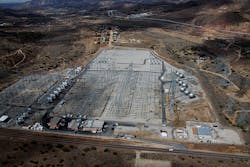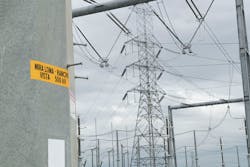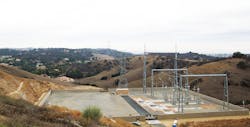SCE Makes Major Substation Upgrades
In a desert north of Southern California, wind turbines are spinning and photovoltaic arrays are soaking up the sun. As part of the recent expansions in the Tehachapi Wind Resource Area, the wind farms alone are capable of producing 4500 MW of energy and powering 3 million homes.
To carry the renewable energy from the Tehachapi Wind Resource Area south to San Bernardino County, Southern California Edison (SCE) constructed more than 170 miles of high-voltage overhead transmission lines and 3.7 miles of underground line, and upgraded and constructed several substations as part of the Tehachapi Renewable Transmission Project (TRTP).
In December 2016, SCE energized the last section of the 500-kV line, which is not only adding capacity to SCE’s electrical system, but also helping to meet California’s renewable energy goals. By tying the wind and solar farms into its high-voltage network, SCE can distribute the clean, green energy to its consumers.
To get the project from conception to completion, SCE created a dedicated organization including project managers, engineers, real estate specialists, procurement agents, material expeditors and environmentalists. Over the course of 11 different phases, the team worked together to effectively interconnect the solar and wind farms to SCE’s system.
Upgrading Substations
As part of TRTP, SCE constructed three brand new substations — Windhub, Whirlwind and Highwind. Each location serves a different purpose. For example, from the beginning of the project, SCE knew Windhub would serve as the entry point for many of the wind developers and eventually tie into the larger wind and solar farms in the Tehachapi Wind Resource Area.
In 2005, the utility planned to develop transmission to transport the renewable energy from the area. By tying into the network, SCE could increase its capacity. Because the wind resource area was located within SCE’s service territory, the utility worked with the developers to come up with a master plan to tie the wind and solar farms into the system.
The Windhub substation was originally built as a 220-kV substation with plans to be upgraded to a 500-kV substation in the future. When the utility had sufficient transmission to step up to a higher voltage, SCE planned to increase the capacity of the system.
The Windhub substation served as the entry point for a lot of the developers as far north as Tehachapi, while the Highwind 220-kV substation was located in a more remote area. Over time, as more developers started coming into the area, SCE started working on the next phases of the project and upgraded the Windhub substation to 500 kV.
Later, SCE created another new substation named Whirlwind to tie into one of the existing Midway–Vincent 500-kV lines, which leads to the Vincent substation. The Whirlwind substation is built on an 85-acre site and was operated as a 500-kV station from its inception.
In addition to constructing new substations, SCE also updated some of its older substations in the area, including Antelope. Originally built back in the 1950s to serve the remote, rural areas in the Antelope Valley, Antelope started out as a 15-acre, 220-kV substation. Recently, however, it has been upgraded to 500 kV, and its switchyard sits on 70 acres of land.
SCE also upgraded the Vincent substation, which was already a 500-kV substation. Three transmission lines tie this substation to the Pacific Gas & Electric Midway substation, and as such, this substation is a critical asset for both utilities. Because this substation serves major urban load centers in Southern California, SCE opted to build out its 500-kV capacity in the southern area of its service territory.
The Vincent substation, originally constructed in the 1960s, was almost at its physical capacity before TRTP even began, and as such, it was important for SCE to expand its switchyard and increase its footprint. Before SCE started the project, Vincent was a 35-acre site, and it was expanded to 50 acres, which gave it more space for the new 500-kV switchyard.
The southern terminus for the overall TRTP line is Mira Loma, which is a 100-acre site. SCE was able to tie the new 500-kV line to Mira Loma into newly constructed positions without the need to increase its size.
Installing Reactors
During the substation upgrade projects, SCE faced some land constraints when it came to adding new equipment. Because it was building a section of underground line, it needed to add reactors. The underground cable portion of the 500-kV line added a lot of capacitance to the Mira Loma–Vincent circuit. As such, SCE needed to control the voltage on the line. If a circuit has a lot of capacitance, it could be difficult to bring the voltage down if it doesn’t have sufficient load on the circuit. With a reactor, however, SCE can lower the voltage as needed so the circuit can operate within the allowable voltage range.
The reactors tie into a line much like a transformer, but unlike a transformer, they do not transform the voltage. Instead, they dampen the voltage down.
SCE analyzed its entire circuit to determine where to install the reactors. This type of equipment can be more or less effective depending on its proximity to the capacitance source, so it was important to pinpoint the best spot for the reactors. The problem, however, was that the capacitance was being increased at the underground line, yet the transition stations from overhead to underground were constrained from the very beginning. The transition stations are very small compared to the other project substations. At only 3 acres in size, they had a small footprint with no space for circuit breakers or reactors.
As a result, SCE shifted its focus to the terminal substations. Vincent, which was already being expanded, could make space for the reactors within this substation, but it was too far north of the underground line to provide the voltage control that it needed for the circuit. While the underground circuit is located 70 miles from Vincent, it is only 10 miles from Mira Loma. Therefore, SCE opted to place the reactors at Mira Loma.
Looking to the Future
From the beginning to the end of TRTP, the renewable energy technology has changed significantly. When SCE first started working with the wind energy developers in the early 2000s, the industry was looking at 1-MW generators, and now 3-MW generators are common.
More than 15 years ago, this part of the Antelope Valley south of Oak Creek Road from the town of Mojave to the Tehachapi Mountains had virtually no wind turbines. Today, utility-scale wind turbines are located throughout this area, which is highly conducive to wind energy production. For about 20,000 acres south of this road, utility-scale wind and solar farms are creating renewable energy. These solar farms feature photovoltaic arrays rather than solar thermal plants, and they cover anywhere from 0.5 sq mile to 1 sq mile in size.
The storage technology of the energy also has changed since the TRTP project first broke ground. By researching and building utility-scale storage facilities, SCE is working on ways to be able to store the renewable energy and then dispatching as needed, similar to a typical gas-fired peaker plant.
To this end, since 2014, SCE has been conducting battery storage research at its Monolith substation; and at 32 MWh, this was one of the largest storage units in North America. Recently, SCE completed the installation of an 80-MWh Tesla energy storage facility at Mira Loma.
By interconnecting its system to renewable energy resources in Southern California, SCE is aiming to provide green energy to its customers. Powered by energy from the sun and wind, these farms are reducing emissions and helping SCE to meet its goal to procure one-third of its electricity by renewables by 2020.
Sidebar: Four Ways to Safeguard Wildlife During a Long-Term Project
The Tehachapi Renewable Transmission Project crossed over many environmentally sensitive areas and spanned years, which required the field workforce to take extra precautions to not impact the environment. Here are four ways the team protected the wildlife during the construction of its high-voltage transmission lines and substations.
- Observing water flow. Southern California Edison (SCE) studied water flow to implement measures that would help to deter erosion.
- Erecting gates around work sites. To keep native wildlife and the public away from the hazardous construction sites, SCE constructed perimeter fences around the construction sites and employed other best management practices.
- Sweeping the area. During constant environmental surveys, dedicated field monitors patrolled the work site to look for animals such as burrowing owls and desert tortoises. The monitors ensured no birds were nesting in construction equipment or material trailers.
- Limiting nesting locations. If the field workers discovered a nest, they made sure they did not disturb it. When possible, however, they tried to implement protective measures to inhibit nesting where they did not want birds to be nesting. For example, they installed bird deterrents, closed up any openings within containers, and placed netting on top of and around outdoor construction equipment and materials.
About the Author
Roman Vazquez III
Senior Project Engineer
Roman Vazquez III is a senior project engineer for Southern California Edison. He served as the manager of the engineering group for TRTP and is a licensed professional engineer in the state of California.







